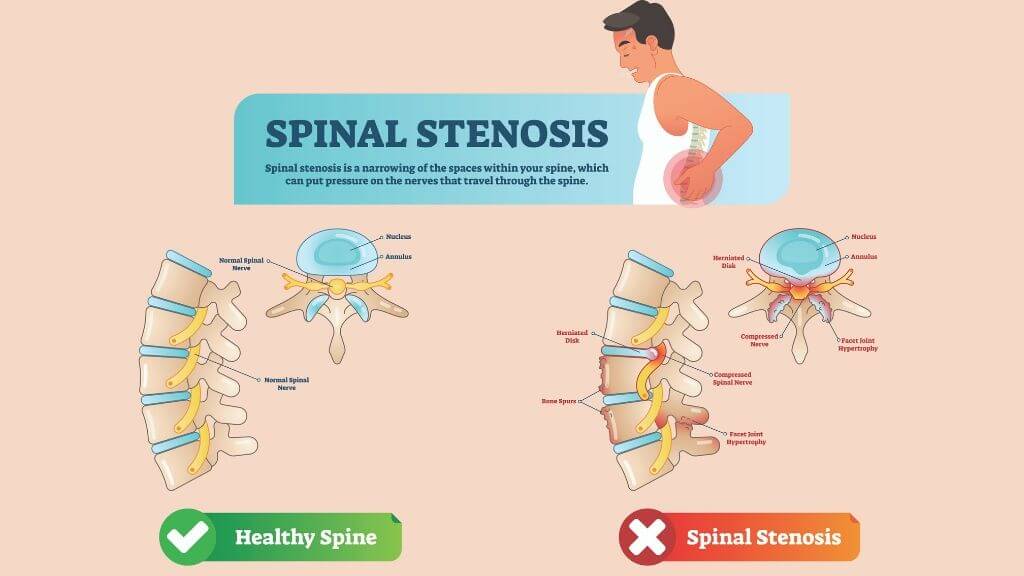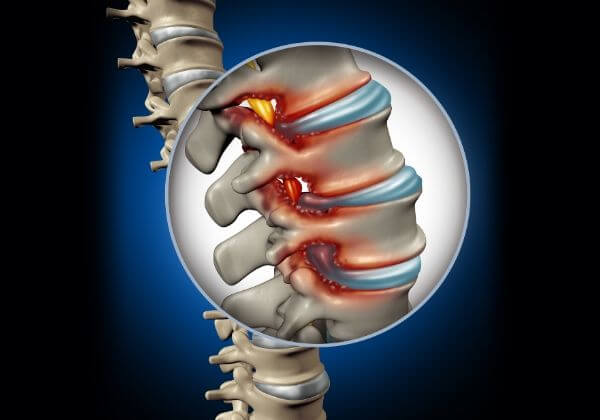Your spine consists of bones stacked together with cartilage, and this provides support and stability to the upper body. The stacking is known as a spinal column. Spinal nerves run through the spinal column allowing for signals to pass between the brain and the rest of the body. The bones or vertebrae in the spine protect these nerves.
Spinal stenosis is a condition where the spinal column narrows and compresses the spinal cord and nerves.
What Causes Spinal Stenosis?
Aging is the most common cause of spinal stenosis, as degeneration occurs naturally through the body as we get older. Tissues can get thicker, and bones can get bigger, which then press against nerves causing damage.
You will experience impaired function in areas where damaged nerves travel. The inflammation caused by rheumatoid arthritis and osteoarthritis can also contribute to excess pressure on the spinal cord.
Other possible causes for spinal stenosis can include:
♦ A naturally narrowing spinal cord
♦ Scoliosis
♦ Spine defects at birth
♦ Paget’s disease, which causes abnormal bone regrowth
Spinal Stenosis Symptoms
The symptoms of spinal stenosis will vary depending on the location of the nerve compression. General symptoms to look for include:
♦ Discomfort in the shoulder
♦ Discomfort or pain when standing
♦ Pain or weakness below the knee
♦ Bilateral symptoms

In addition to these physical symptoms, neurological conditions can result as nerves get compressed or damaged.
♦ Cervical myelopathy: the nerves in the cervical spinal cord get pinched causing imbalance, weakness or paralysis, and loss of bladder control.
♦ Radiculopathy: nerve dysfunction causes weakness and loss of sensation and reflex.
♦ Cauda equina syndrome: Lower back nerves become pinched, causing lower extremity pain, numbness, and bowel dysfunction.
Spinal Stenosis Diagnosis
Your doctor will start with a review of your medical history and a physical exam to observe your movements. Additional tests may be done to confirm a diagnosis, depending on what your doctor observes.
X-rays and scans can show images of the spine to detect damage, or an electromyogram can be used to analyze the health of your spinal nerves. Finally, a bone scan may be done to identify growths in your spine.
Treatment for Spinal Stenosis
The first treatment option provided for spinal stenosis is medication to reduce pain. Cortisone injections directly into your spinal column can reduce swelling and muscle pain, or NSAIDs can be taken orally to reduce inflammation and pain.
Physical therapy is also recommended to strengthen muscles and gradually and gently stretch your body without exerting pressure on the spine.
Spinal Stenosis Diet
The best diet to follow for reducing symptoms is an anti-inflammatory diet. Inflammation can worsen symptoms by adding additional pressure to compressed nerves. Reducing inflammation can improve symptoms and quality of life.

The number one thing to consume for reduced inflammation is omega-3 fatty acids. These can be taken as a supplement or found in fatty fish, seeds and nuts, and healthy oils like olive oil.
You need to avoid omega-6 fatty acids, which increase inflammation. These are commonly found in dairy products. Omega-9 fatty acids can also fight inflammation, and you can get these through avocados and nuts.
You can also reduce inflammation by avoiding fatty meats, sugars, and processed foods. Foods high in fats and sugars increase inflammation as do stimulants such as alcohol and caffeine. A diet rich in organic fruits and vegetables can combat inflammation, but certain vegetables in the nightshade family (tomatoes, potatoes, bell peppers) should be avoided.
Natural Treatments for Spinal Stenosis
In addition to medications or surgery, there are things you can try to ease pain, such as the application of heat or ice packs, massage, and acupuncture. Many people also benefit from cognitive behavioral therapy as a way of helping to cope with pain and to more effectively manage the condition.
The pain of spinal stenosis can significantly impact your quality of life. Learning to better cope with the condition brings relief to many people.
Spinal Stenosis Surgery
When the first approaches to treatment do not work, surgery for spinal stenosis may be an option.
Surgery is typically reserved for cases where the pain is severe or when there is a neurological loss. The types of surgery used to treat this condition are:
♦ Laminectomy: part of your vertebrae is removed to give your nerves more room
♦ Foraminotomy: part of the spine where the nerves exit is widened
♦ Spinal fusion: This is used for severe cases when different levels of the spine are affected. Bone grafts and implants (metal) are inserted to attach bones of the spine together to reintroduce stability.
What Are the Variations of Spinal Stenosis?
The most common types of spinal stenosis are cervical, lumbar, and thoracic.
♦ Cervical spinal stenosis: This occurs at the neck, and is more dangerous, possibly causing major body weakness and paralysis when nerves in this area become compressed.
♦ Lumbar spinal stenosis: This occurs in the lower back and can lead to sciatica when the nerves get compressed.
♦ Thoracic spinal stenosis: This is less common and occurs in your mid-back.
Spinal Stenosis Statistics
♦ 1 in every 1,000 people over the age of 65 have spinal stenosis.
♦ Between 250,000 and 500,000 adults in the United States experience symptoms of spinal stenosis.
♦ 8 to 11 percent of people experience lateral nerve entrapment.
♦ The number of Americans affected by spinal stenosis is expected to grow to 18 million in the next decade.
What Is the Long-Term Outlook?
The outlook for those with spinal stenosis can be positive. Many individuals live full and active lives with appropriate treatment plans.
Depending on the severity of nerve damage and spinal pain, you may need to modify your physical activity, but your doctor can help you design and follow the best treatment plan for you. Even after surgery, there can be residual pain, so the overall outlook will depend on how well you keep up with treatment.







